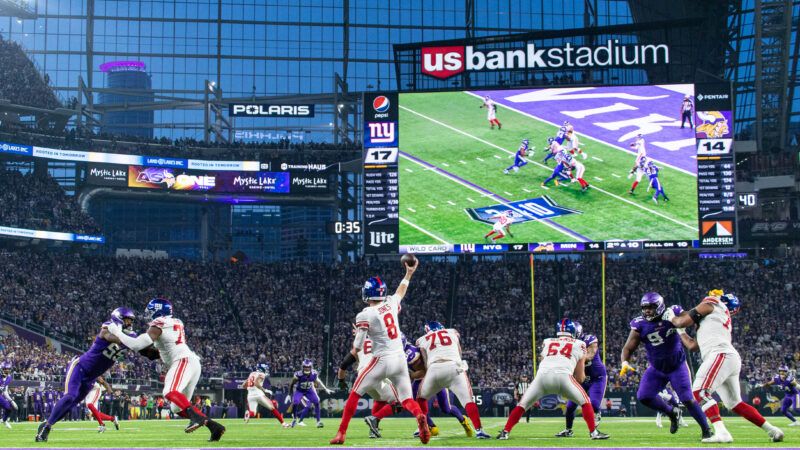Minnesota Taxpayers Could Be Pillaged for $280 Million in Vikings' Stadium Upgrades
Taxpayers spent about $500 million to build U.S Bank stadium, which is just seven years old.

Taxpayers fronted nearly $500 million for a new professional football stadium in Minneapolis that opened just seven years ago. Now, they could be on the hook for as much as $280 million more in ongoing maintenance costs over the next decade.
Despite being no older than a second-grader, U.S. Bank Stadium is reportedly in need of several major upgrades and there is not enough money set aside in the stadium's reserve fund to cover those costs, according to a report from the Minneapolis-based Star Tribune. There's about $16 million set aside now, but maintenance and upgrade costs will hit $48 million next year, according to the new assessment. The chairman of the organization that oversees the stadium isn't shy about the fact that taxpayers will be expected to pick up some of the tab.
"Is there sufficient money to cover these? The answer to that is no," Michael Vekich, chair of the Minnesota Sports Facilities Authority, told the Star Tribune. "That is the work that we have to do collectively with [stadium operator] ASM, the Minnesota Vikings and…the governor and the Legislature."
That's on top of the $15.7 million in new taxpayer funding that was included in last year's state budget to upgrade the security perimeter around the stadium and another $48 million that Vekich told the Star Tribune will be necessary to finish the perimeter.
All in all, the story of U.S. Bank Stadium is a useful warning about how the price tag for publicly funded stadiums can continue to balloon even after construction is over. It should also blow a massive hole in the argument most commonly made by advocates for public stadium subsidies: that stadium projects pay for themselves in the long term by generating economic growth. Study after study has disproven that argument, but here's a succinct illustration of the problem. If the stadium was paying for itself, why would taxpayers have to pick up the tab for routine maintenance?
There's also a major conflict of interest here, as stadium subsidy skeptic Neil deMause pointed out on his Field of Schemes blog. The laundry list of necessary (and expensive) upgrades to U.S. Bank Stadium was compiled by Populous, a stadium design and construction firm that is likely to bid on much of the future work. It's like a car salesman telling you that you should buy a new car, and the best news is that you can get someone else to pay for it!
These sorts of ongoing obligations for stadium maintenance are the latest angle in the stadium subsidy scheme. It's not just Minneapolis. Cincinnati is trying to figure out how to pay for $500 million in upgrades to its 23-year-old football stadium. Maryland created a $1.2 billion slush fund for stadium upgrade costs last year, with the NFL's Baltimore Ravens and MLB's Baltimore Orioles as the primary beneficiaries.
Another reason why these public projects so rarely "pay for themselves" is that cities often grant huge property tax breaks to the stadiums. In New York City, for example, a recent report from the city's Independent Budget Office found that the four major stadiums in the Big Apple—Barclays Center, Citi Field, Madison Square Garden, and Yankee Stadium—are exempt from roughly $377 million in annual property taxes.
While Madison Square Garden's situation is weird and unique, the other three stadiums are exempt because they "were all built on publicly owned land that is exempt from property taxes," according to the IBO report. But there's nothing actually "public" about a stadium—they're not parks that anyone can visit whenever they'd like or use for a variety of purposes—and cities should stop engaging in the fiction that they are.
Most importantly, the IBO report found that "there is little evidence that these types of subsidies generate sufficient economic activity to lead to a net fiscal benefit to the local area."
To sum up: Taxpayers are forced to cover stadium construction costs with the promise of economic growth that doesn't materialize, then sometimes get hit up for ongoing maintenance costs that can't be covered by the economic growth that didn't materialize, and all this happens while the supposedly public stadiums are not generating property tax revenue to help offset their public costs. It's a bad deal for just about everyone—except for the stadium design firms that get to decide how much extra cash taxpayers will have to pony up to maintain a facility that's still basically brand new.
Show Comments (29)